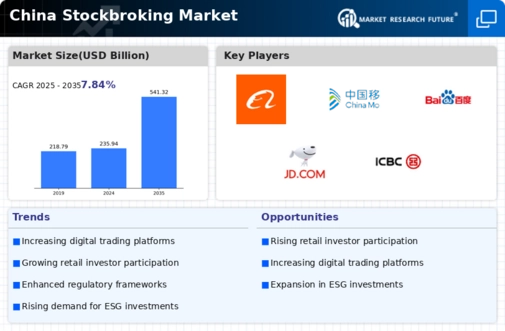Evolving Regulatory Landscape
The evolving regulatory landscape in China is a critical driver for the stockbroking market. Recent reforms aimed at enhancing market transparency and investor protection are reshaping the operational framework for stockbrokers. As of November 2025, the introduction of stricter compliance measures has led to a more secure trading environment, which may bolster investor confidence. Additionally, the government is actively promoting policies that encourage foreign investment, potentially increasing the participation of international players in the stockbroking market. This regulatory evolution could lead to a more competitive landscape, fostering innovation and growth within the industry.
Expansion of Online Trading Services
The expansion of online trading services is significantly influencing the stockbroking market in China. With the proliferation of internet access and mobile technology, online trading platforms have become increasingly accessible to a wider audience. As of November 2025, it is estimated that online trading accounts for over 80% of all trading activities in the market. This shift towards online services is likely to enhance competition among stockbrokers, driving them to innovate and improve their service offerings. Additionally, the convenience of online trading may encourage more individuals to enter the stockbroking market, further stimulating growth and participation.
Rising Demand for Sustainable Investments
The stockbroking market in China is witnessing a rising demand for sustainable investments, reflecting a broader global trend towards responsible investing. As of November 2025, approximately 40% of investors express a preference for environmentally and socially responsible investment options. This shift is prompting stockbrokers to adapt their offerings, incorporating ESG (Environmental, Social, and Governance) criteria into their investment products. The growing interest in sustainable investments may not only attract a new segment of investors but also encourage existing investors to diversify their portfolios. Consequently, the stockbroking market could experience a transformation in investment strategies, aligning with the values of a more conscientious investor base.
Increased Financial Literacy Among Investors
There is a growing trend of increased financial literacy among the Chinese population, which is positively impacting the stockbroking market. Educational initiatives and online resources have empowered individuals to make informed investment decisions. As of November 2025, surveys indicate that approximately 70% of new investors have engaged in financial education programs, leading to a more knowledgeable investor base. This heightened awareness is likely to result in more strategic trading behaviors, fostering a more robust market environment. Consequently, the stockbroking market may witness a surge in trading volumes as these educated investors actively participate in the market.
Technological Advancements in Trading Platforms
The stockbroking market in China is experiencing a notable transformation due to rapid technological advancements in trading platforms. These innovations enhance user experience, allowing for faster transactions and improved accessibility. As of November 2025, the integration of artificial intelligence and machine learning into trading systems appears to optimize trading strategies, potentially increasing profitability for investors. Furthermore, mobile trading applications have surged in popularity, with over 60% of retail investors utilizing these platforms for their trading activities. This shift towards technology-driven solutions is likely to attract a broader demographic to the stockbroking market, thereby expanding its overall reach and engagement.

















Leave a Comment